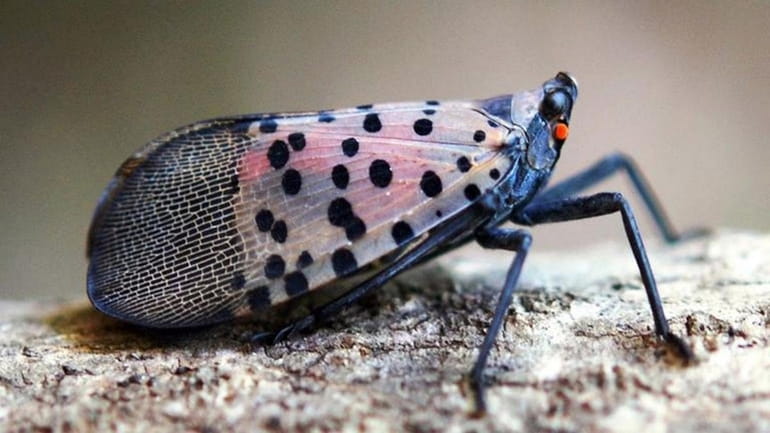Spotted lanternflies spreading on Long Island, seen as far as Montauk

The spotted lanternfly is harmless to people and pets but since it can cause so much damage to agriculture, officials are asking people to kill it by stomping on the bug. Credit: Pennsylvania Department of Agriculture
Spotted lanternflies, the invasive, voracious insect that can destroy certain trees and grapevines, have established a population as far east as Wading River and been seen in Montauk, officials said Thursday.
Agricultural officials now say don't bother reporting them in Nassau County and western parts of Suffolk, because they are aware of the large numbers in those areas.
Vineyard owners on the East End believe they have escaped the wrath of the lanternfly for this season, but aren't as optimistic about next year.
As of Thursday, there have been sightings, though not infestations, as far out as Riverhead, Baiting Hollow, East Hampton and Montauk, state officials said.
"For Suffolk County, we are still asking residents to report sightings from areas east of Bohemia/Stony Brook," said Jola Szubielski, a spokeswoman for the state Department of Agriculture and Markets. Almost all areas west of Bohemia and Stony Brook have confirmed spotted lanternfly populations to varying degrees.
Here is what to know:
As the population expands throughout Long Island, people are also noticing them more. Smaller nymphs have turned into adults with their distinctive red spotted wings, making them more visible than earlier in the summer, experts said.
“The adults are large, very active, easy to see, and may be aggregating on favorite hosts,” said Dan Gilrein, an entomologist and associate agricultural program director at Cornell Cooperative Extension of Suffolk County.
They are often found "where people spend time" and even land on them, he said.
Reports in the media and on social media may have also increased awareness, he said.
Their activity and population will decline as the cooler weather sets in, Gilrein said.
Confirmed reports of the adult-stage spotted lanternfly have come in from just about all of Nassau County, according to the New York State Department of Agriculture and Markets. There have also been numerous sightings in western Suffolk.
The agency said it has received multiple reports from as far east as Shirley, Mastic, Coram and Patchogue as well as “isolated finds” in Riverhead and Baiting Hollow, and East Hampton and Montauk.
Gilrein said the individual sightings show the “hitchhiking tendencies” of the insect and why it spreads so quickly.
Nassau and Suffolk counties have 592 farms and 31,000 acres of farmland, according to the Long Island Farm Bureau. Suffolk County is home to most of that farmland as well as 69 wineries, which is the largest number in the state.
While its preferred host is the tree of heaven, another invasive species from Asia, it also eats grapevines.
Because the spotted lanternfly can feed in a large swarm, it can “weaken the vine, leading to loss of winter hardiness, reduced or no return bloom or crop, and even vine death,” according to information from the New York State Integrated Pest Management at the Cornell University College of Agriculture and Life Sciences, which said the insect is a serious pest of both cultivated and wild grapes.
Kareem Massoud, a winemaker for Paumanok Vineyards in Aquebogue, said vineyard owners on Long Island have been watching for the spotted lanternfly since it first appeared in Pennsylvania in 2014.
“I describe it as a slow motion train wreck," he wrote in an email. "You can see it coming, but there is not a lot you can do to avert the consequences.”
He said scientists at Penn State University and Cornell University have been looking for better ways to manage the pest.
“So far there are no reported infestations on the East End, only individual insects,” said Massoud, who is also president of Long Island Wine Country. “So it seems we will make it through the 2023 season without an issue, but we are bracing ourselves for the first real problems to present in 2024.”
The spotted lanternfly is harmless to people and pets but since it can cause so much damage to agriculture, officials are asking people to kill it by stomping on the bug.
If they spot the bug east of the areas of Bohemia and Stony Brook, they should document the sighting and report it to the state Department of Agriculture and Markets. That can be found at agriculture.ny.gov/ReportSLF.
Reports are not needed from sightings in central and western Long Island since the agency is already aware of its presence there,according to the Cornell Cooperative Extension of Suffolk County. Residents are still being asked the kill the bugs when they see them.
Spotted lanternflies, the invasive, voracious insect that can destroy certain trees and grapevines, have established a population as far east as Wading River and been seen in Montauk, officials said Thursday.
Agricultural officials now say don't bother reporting them in Nassau County and western parts of Suffolk, because they are aware of the large numbers in those areas.
Vineyard owners on the East End believe they have escaped the wrath of the lanternfly for this season, but aren't as optimistic about next year.
As of Thursday, there have been sightings, though not infestations, as far out as Riverhead, Baiting Hollow, East Hampton and Montauk, state officials said.
"For Suffolk County, we are still asking residents to report sightings from areas east of Bohemia/Stony Brook," said Jola Szubielski, a spokeswoman for the state Department of Agriculture and Markets. Almost all areas west of Bohemia and Stony Brook have confirmed spotted lanternfly populations to varying degrees.
Here is what to know:
Why am I seeing so many spotted lanternflies now?
As the population expands throughout Long Island, people are also noticing them more. Smaller nymphs have turned into adults with their distinctive red spotted wings, making them more visible than earlier in the summer, experts said.
“The adults are large, very active, easy to see, and may be aggregating on favorite hosts,” said Dan Gilrein, an entomologist and associate agricultural program director at Cornell Cooperative Extension of Suffolk County.
They are often found "where people spend time" and even land on them, he said.
Reports in the media and on social media may have also increased awareness, he said.
Their activity and population will decline as the cooler weather sets in, Gilrein said.
Where are they on Long Island?
Confirmed reports of the adult-stage spotted lanternfly have come in from just about all of Nassau County, according to the New York State Department of Agriculture and Markets. There have also been numerous sightings in western Suffolk.
The agency said it has received multiple reports from as far east as Shirley, Mastic, Coram and Patchogue as well as “isolated finds” in Riverhead and Baiting Hollow, and East Hampton and Montauk.
Gilrein said the individual sightings show the “hitchhiking tendencies” of the insect and why it spreads so quickly.
Why is it important to track their path in eastern Suffolk?
Nassau and Suffolk counties have 592 farms and 31,000 acres of farmland, according to the Long Island Farm Bureau. Suffolk County is home to most of that farmland as well as 69 wineries, which is the largest number in the state.
While its preferred host is the tree of heaven, another invasive species from Asia, it also eats grapevines.
Because the spotted lanternfly can feed in a large swarm, it can “weaken the vine, leading to loss of winter hardiness, reduced or no return bloom or crop, and even vine death,” according to information from the New York State Integrated Pest Management at the Cornell University College of Agriculture and Life Sciences, which said the insect is a serious pest of both cultivated and wild grapes.
Are Long Island wineries affected this year?
Kareem Massoud, a winemaker for Paumanok Vineyards in Aquebogue, said vineyard owners on Long Island have been watching for the spotted lanternfly since it first appeared in Pennsylvania in 2014.
“I describe it as a slow motion train wreck," he wrote in an email. "You can see it coming, but there is not a lot you can do to avert the consequences.”
He said scientists at Penn State University and Cornell University have been looking for better ways to manage the pest.
“So far there are no reported infestations on the East End, only individual insects,” said Massoud, who is also president of Long Island Wine Country. “So it seems we will make it through the 2023 season without an issue, but we are bracing ourselves for the first real problems to present in 2024.”
What do I do if I see a spotted lanternfly?
The spotted lanternfly is harmless to people and pets but since it can cause so much damage to agriculture, officials are asking people to kill it by stomping on the bug.
If they spot the bug east of the areas of Bohemia and Stony Brook, they should document the sighting and report it to the state Department of Agriculture and Markets. That can be found at agriculture.ny.gov/ReportSLF.
Reports are not needed from sightings in central and western Long Island since the agency is already aware of its presence there,according to the Cornell Cooperative Extension of Suffolk County. Residents are still being asked the kill the bugs when they see them.

